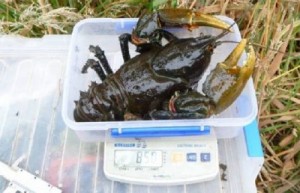Population monitoring of the nationally endangered Glenelg Spiny Crayfish (Euastacus bispinosus) within rising spring habitats of the Lower South East of South Australia.

Female Glenelg Spiny Crayfish with eggs (in berry)
The Glenelg Spiny Crayfish (Euastacus bispinosus), or Pricklybacks as they’re affectionately known, have a restricted distribution – naturally occurring only in the Lower South East of South Australia and South West of Victoria. In the South East of South Australia, the species is restricted to only five known rising-spring habitats and associated creeks or in some cases, drains. In 2006, Aquasave Consultants conducted the first study to inclusively monitor the Glenelg Spiny Crayfish population in South East South Australia. This monitoring highlighted the vulnerability of the species, with alarmingly low abundance. The population was estimated at less than 500 individuals across a small core area of occurrence of only 24 km2. There was also a notable sex bias towards females (inferring fishing pressure) and large proportion of individuals with irregular sexual characteristics. These outcomes contributed to the escalation of the conservation status of the species to endangered nationally and closure of the recreational fishery in February 2011.
In 2011, Aquasave Consultants reassessed the conservation status of the South East South Australia population under a contract to Friends of Parks (Mount Gambier) through the Department of Environment and Natural Resources (DENR)’s South East Cooperative Coastal Conservation Initiative (a Caring for Our Country funded project) project. Together DENR and the Friends of Mount Gambier Area Parks are focusing on restoration activities necessary for successful recovery. There has been a high level of participation in the monitoring program from both landholders and community members. This active participation has been important for increasing local understanding of the species, its habitat and required recovery actions.

Heaviest Pricklyback (110 mm OCL, 850 g) from both field trips
The outcomes of the 2011 monitoring indicate that persisting Glenelg Spiny Crayfish sub-populations are present in known and new rising-spring habitats across the restricted core area of occurrence. However, many of these sub-populations contained low numbers, had poor or no signs of recruitment, were dominated by large and presumably aging crayfish, and contained a high percentage of individuals with gonopore aberrations. Of most concern was the declining trend in both CPUE and condition of rising-spring habitat over the five years from the 2006 survey to the present monitoring. As such, the conservation assessment concluded that the species remains ‘Critically Endangered’ in South Australia, with an extreme risk of localised, and regional, extinction.
A review of management actions highlighted that some progress (i.e. revegetation, reinstalling of physical habitat) has been made, but clearly much more work is required to ensure the conservation of Glenelg Spiny Crayfish within South Australia. These outcomes will provide critical information to guide the direction of these future restoration activities.
For more information, contact Nick and see:
Whiterod, N. and Hammer, M. (2012). Population monitoring of Glenelg Spiny Crayfish (Euastacus bispinosus) in rising-spring habitats of lower south east, South Australia. Report to the Friends of Parks Inc. Aquasave Consultants, Adelaide. p. 27.
- NGT out and about: Photos from the field 31/03/2023
- Glenelg Spiny Crayfish open day: join us for snorkelling at Ewens Ponds! 20/12/2022
- Flashbacks to Blackfish: Lachie revisits past lives and reflects on the importance of permanent pools in waterways 14/06/2022
- Historical insights into “Pricklyback” Glenelg Spiny Crayfish – we need your help! 23/11/2021
- Glenelg spiny freshwater crayfish back in the spotlight 31/08/2021
- Karst Rising Springs event at Port MacDonnell a great success! 31/05/2016
- Our coastal Karst Rising Springs are in the spotlight this May! 11/05/2016
- Papers on the status of Glenelg Spiny Crayfish 23/05/2014
- Preliminary genetic investigation prompts Glenelg Spiny Crayfish workshop 24/05/2013
- Summing up the World Wetlands Day event at the Mt Gambier Library 20/02/2013

